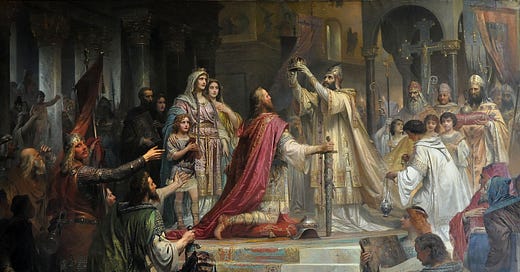Coronation of Charlemagne: A Ploy to Marry into the Byzantine Empire
An attempt to make the Marriage of a Millennium
On Christmas Day 800, Pope Leo III crowned Charlemagne as Imperator Romanorum, Emperor of the Romans. Normal historiography interprets this move as a reward by Pope Leo III for Charlemagne’s support for the papacy in local Italian affairs. Over the previous decades, the waning power of Byzantine Empire over central Italy meant that the Papacy had to increasingly turn North to the Franks to retain temporal and in extreme cases ecclesiastical control of Rome and her environs.
Pope Leo III himself was personally in debt to then King Charles, as just the year before a violent mob had driven him out of Rome. Fleeing to Charles’ Court in Paderborn, it was Charles’ soldiers and regal authority which allowed Pope Leo III to retake St. Peter’s seat early in 800. It is in this context that most view Charlemagnes’ coronation.
But if a wider view of the political landscape is cast, then Charlemagnes’ coronation may have been a political ploy to secure a favorable marriage with Empress Irene of Byzantium and create a dynastic renovatio imperii.
Empress Irene was the first woman to rule the Byzantine Empire in her own right and her path to the throne, the blinding and deposition of her own sovereign son Constantine VI via a palace coup in 797, did not help her legitimacy. Military losses to the Muslim Caliph Al Rashid only served to weaken her political position further. Mired in these domestic and military problems, some sources claim that in 799 Irene sent an emissary to Charlemagne asking for a marriage alliance to reunite East and West as one Empire.
Both sides, Byzantine and Frankish, have sources supporting a 799 diplomatic visit, but they disagree on the outline of the deal. Eastern sources claim the marriage would be largely titular: Irene would rule in the Constantinople, while Charles would rule in Aachen. Irene would gain a powerful ally in the West to potentially help shore up her position in Constantinople and perhaps even the frontier against Muslim incursions. Charles would gain the prestige and glory of Roman imperial titulature. Western sources naturally magnify the terms, claiming that Empress Irene ‘offered to hand over the Empire to Charles,’ meaning a the Empire would be governed by a single court and administrative system with Charles as Roman Emperor.
The exact specifics of the deal are ultimately irrelevant. If a diplomatic embassy did come from the Byzantines, Charlemagne was still married to his fourth wife Luitgard in 799 making any marriage alliance tricky. It would not be until the summer of next year, that the King would become eligible for marriage again with the Luitgard’s passing. Despite Luitgard being Charlemagne’s fourth wife, her death would still likely have caused questions of remarriage to be raised.
Even if there was no 799 overture from Irene, the idea of the political marriage for the purpose of a restored or enhanced Roman Empire, would not be outside the scope of Charlemagne’s imagination. Nearly 20 years earlier, Constantinople had arranged a betrothal of Constantine VI to Charlemagne’s daughter Rotrud. He had chosen to break of the engagement, likely fearful of dynastic infighting, to disastrous results. Soon after the betrothal was broken, Byzantium would use the Lombards of Southern Italy to initiate a proxy war to the irritation of Charlemagne and the Papacy.
One way or another, Charlemagne knew the potential was there for a union of the two families. The real question was what the shape of the marriage contract and union would look like. While the Byzantine Empire was much reduced and Charles’ Kingdom on the rise, Byzantium still held tremendous legacy prestige and authority. Empress Irene held the better end of the bargaining as granting King Charles the titulature and legitimacy of Roman Emperor alone was a significant boon.
The natural move would be to undercut Irene’s position by declaring Charles as Emperor in his own right. Doing so, he could drive a harder bargain during negotiations. Undercutting negotiating capital would also add to why the legal justification focused on Empress Irene’s womanhood and fabricating a vacant throne. Doing so meant Charlemagne was claiming sovereignty over the whole Roman Empire, not simply a restored Western Empire. Effectively, Charlemagne was flipping the political situation on it’s head: Irene was the illegitimate and it was her who would need Charlemagne’s hand to shore up her claim to Imperial status.
After his Christmas Day coronation in 800, Charlemagne would send envoys to Empress Irene the very next year, instructing them to make an offer of marriage. There are conflicting reports on what happens next. One Byzantine chronicler has the envoys successfully arriving at court and making their offer. According to the source, the Empress seemed close to accepting the proposal and bringing about a united East and West. It was only the influence of traitorous courtiers who persuaded Irene to delay making a decision, so that they could successfully depose her. Other sources have the envoys arriving after Irene’s deposition.
With the marriage of a millennium now gone, the title of Emperor served no real purpose except to inflame relations between East and West. Charlemagne himself would come to dislike the title according to his court chroniclers.
The bitterness of a bungled plot.



